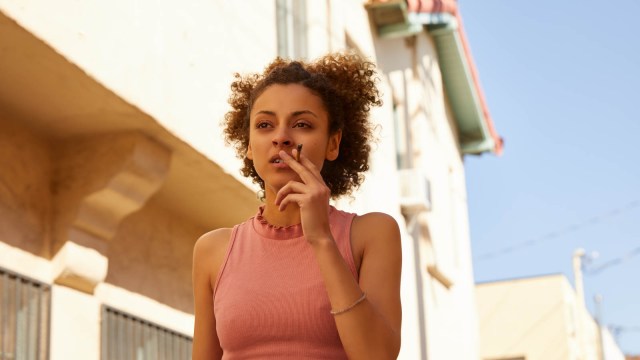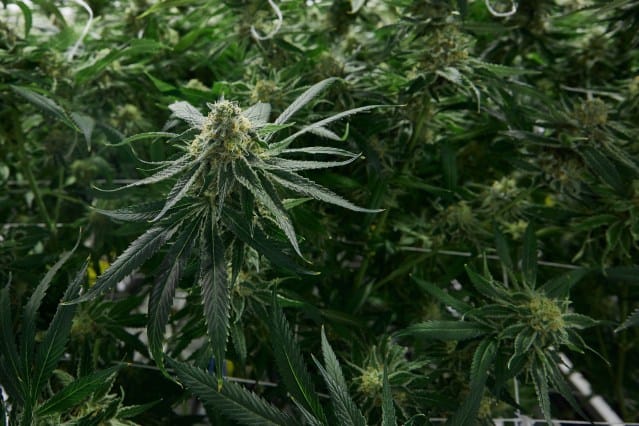You've likely seen cannabidiol (CBD) everywhere from drugstore gummies to boutique coffee concoctions. But there's reason to believe smoking high-CBD flower might be one of the most effective ways to experience the potential benefits of CBD.
If you're curious about smoking CBD flower and want to explore the pros and cons, this is the guide for you. And if you're looking for a literal guide to smoking, we have a guide for that, too.

The difference between smoking CBD and THC
Contrary to popular belief, tetrahydrocannabinol (THC) and CBD have a lot in common. They're the most abundant cannabinoids found in cannabis plants and they both have the potential to help with anxiety. They even have the same chemical structure (the atoms are just arranged differently). The main difference between THC and CBD can be summed up in one word: intoxication.
CBD is often touted as nonpsychoactive or having no psychoactive effects, but it's more accurately described as nonintoxicating. Why? Even though CBD won't get you high, that subtly calm feeling you might experience after taking some CBD tincture is technically a psychoactive effect. Any substance that has a direct effect on the function of the brain is considered psychoactive. By contrast, THC can be intoxicating even at low doses.

Why this happens has to do with how THC and CBD interact with the body's endocannabinoid system (ECS). The human endocannabinoid system consists of the cannabinoid receptors found throughout the body. The body's most studied cannabinoid receptors are the Cannabinoid-1 and Cannabinoid-2 receptors (CB1 and CB2), and they are found in the central nervous system, the peripheral nervous system, and the immune system.
THC binds with the CB1 receptors in the brain to produce that classic weed high, while CBD has been shown to have the opposite interaction with CB1 receptors, acting as an antagonist. When consumed together, CBD appears to improve the therapeutic and enjoyable effects of THC by minimizing the unwanted side effects such as anxiety and a rapid heartbeat.

Why consumption method matters
The consumption method plays a critical role in how long it will take to feel the effects of CBD. Inhalation is considered an effective delivery method for CBD because of how quickly the body absorbs it. When CBD is smoked or vaped, cannabinoids enter the lungs and then the bloodstream, circulating throughout the body from there.
While some cannabis consumers and patients prefer to take their CBD through oral administration or topical application, others have found inhalation to be the most effective way to consume. And there may be some science to support this preference.
According to Dr. Adie Rae, a neuroscientist and scientific adviser to Weedmaps, “The bioavailability of CBD is greater through the lungs than through the gut. Specifically, about half of the CBD you inhale makes it into the blood, but only 5% of the CBD you eat gets into your blood." A Chemistry & Biodiversity study published in 2017 confirms this, stating that while the bioavailability can vary based on how the CBD is smoked, “smoking… provides a rapid and efficient method of drug delivery from the lungs to the brain.”
As an added benefit, the effects are felt almost immediately after inhalation. The effects of edibles, on the other hand, can take up to two hours to kick in.

The benefits of smoking CBD
Of the emerging research into CBD's potential medical benefits, there is concrete scientific evidence for its effectiveness in the treatment of epilepsy by reducing seizures. So much so that the United States Food and Drug Administration (FDA) approved a CBD-based drug to treat childhood epilepsy. But that's the only hard scientific evidence on the cannabinoid.
Anecdotally, cannabis consumers have used CBD to alleviate depression, anxiety, insomnia, and pain. But until multiple studies confirm the anecdotal benefits of CBD and the benefits of smoking CBD specifically, that's all they are — anecdotal.
The good news is there is a lot of clinical evidence that CBD is safe to consume, even in large quantities. A clinical trial published in CNS Drugs in 2019 showed that healthy individuals who received 1500 mg of CBD twice per day experienced very few adverse reactions and all were mild. For context, most CBD products on the market today contain 10 mg per serving.
Because CBD poses minimal risks even in large quantities, you should be able to experiment with smoking CBD flower without fear of overdoing it.

The side effects of smoking CBD
Because smoking CBD involves — no shocker here — smoke inhalation, there is the risk of developing respiratory issues. Whenever you combust plant material, toxins called polyaromatic hydrocarbons form. Polyaromatic hydrocarbons exist in both tobacco and cannabis smoke and exposing yourself to those toxins is one of the risks of smoking weed.
Luckily, smoking cannabis doesn't have the same risks as smoking cigarettes. While smoking CBD flower in excess may lead to respiratory issues (like bronchitis or, in severe cases, COPD), there has been no causal link found between smoking weed and cancer, one of the biggest risks associated with smoking cigarettes. Smoking anything, including cannabis, has potential risks.
A 2007 study published in the Harm Reduction Journal examined self-reported respiratory symptoms in participants who used cigarettes and cannabis. The study found that using a vaporizer could decrease respiratory symptoms in regular cannabis users who smoke.
In addition to possible respiratory issues caused by smoke inhalation, CBD does interact with some prescription drugs so check with your doctor before smoking it.
Hemp flower vs. high-CBD flower
While they may sound similar, the difference will largely dictate where you can buy these products — or if you can buy them at all.

The hemp plant produces a broad range of cannabinoids, including THC, the intoxicating cannabinoid in marijuana. However, hemp does not produce enough THC to be intoxicating when consumed.
Although the hemp plant doesn't produce a significant amount of THC, it is capable of producing the non-intoxicating and medicinally rich CBD in high concentrations. And certain strains of hemp produce flowers that look indistinguishable from the high-THC cannabis you'll find at legal dispensaries.
Many countries differentiate hemp from marijuana by the amount of THC produced. In the US, industrial hemp is defined as a Cannabis sativa L. plant containing no more than 0.3% THC by weight. Thanks to the Farm Bill of 2018, you can legally buy hemp flower online in nearly every state.
High-CBD flower is only available for purchase in licensed dispensaries in states where it's legal since it contains THC levels higher than the cutoff for hemp. While it contains higher levels of CBD than most cannabis flower on the legal market, it'll typically contain significant levels of THC as well.
How does smoking CBD feel?
The experience of smoking CBD vary depending on the product and the individual who is consuming the CBD. For example, dabbing a pure CBD isolate will likely cause different effects than hitting a high-CBD vape pen that also contains some THC.
While CBD won't get you high or intoxicated, it may provide a sense of calm, relaxation, and well-being. Depending on the dose and the individual, CBD might have sleepy, relaxed, happy, or even energetic vibes. While there are no serious side effects reported with CBD, overconsumption can cause drowsiness.
In addition to feelings of relaxation, some report feeling a quick relief of swelling and pain after smoking CBD.

Frequently asked questions
Is smoking CBD safe?
While more research into the effectiveness of CBD consumption methods is needed, most evidence suggests that smoking CBD flower will not cause intoxication. The primary concern for users is getting unadulterated CBD and, for those who prefer smoking, the potential long-term consequences for the lungs. CBD does interact with some prescription drugs so check with your doctor before trying it.
Can you smoke CBD oil?
CBD can be infused into a variety of products, including vape juice, edibles, capsules, and CBD oil tinctures. CBD tinctures are strictly for ingestion, while CBD oils are made for inhalation.
CBD vape juice, sometimes referred to as CBD vape oil, may vary in concentration depending on state-specific laws. It is legal in 30 states. Another 17 states have CBD-specific laws that enable some level of use or consumption.

The FDA has not stepped in to regulate CBD products, but in 2018 the FDA approved the prescription use of Epidiolex, a purified form of CBD oil, for treating epilepsy.
Rick Simpson Oil, named after its Canadian developer who claims he cured his own skin cancer with a custom blend of cannabis oil, is a popular form of CBD oil that is commonly smoked.
CBD oil derived from industrial hemp plants only contains CBD, while marijuana-derived products, such as Rick Simpson Oil, have a high concentration of THC and the full range of cannabinoids found in the cannabis plant.
Does CBD kill your high?
The answer isn't clear, but CBD has demonstrated the ability to moderate a high produced from THC by preventing the body from absorbing it. Some people say they use CBD when they get too high to reduce the effects. Evidence suggests CBD actually interferes with the activity of the CB1 receptor, especially in the presence of THC.
So, when THC and CBD work together to affect CB1 receptor activity, users tend to feel a more mellow high and are said to have a reduced chance of experiencing paranoia compared with the effects felt when CBD is absent in a product. This synergistic relationship is often referred to as the “entourage effect,” which explains why certain combinations of cannabinoids and terpenes seem to enhance the benefits of cannabis.
The best smokable CBD products are available in our store!!
